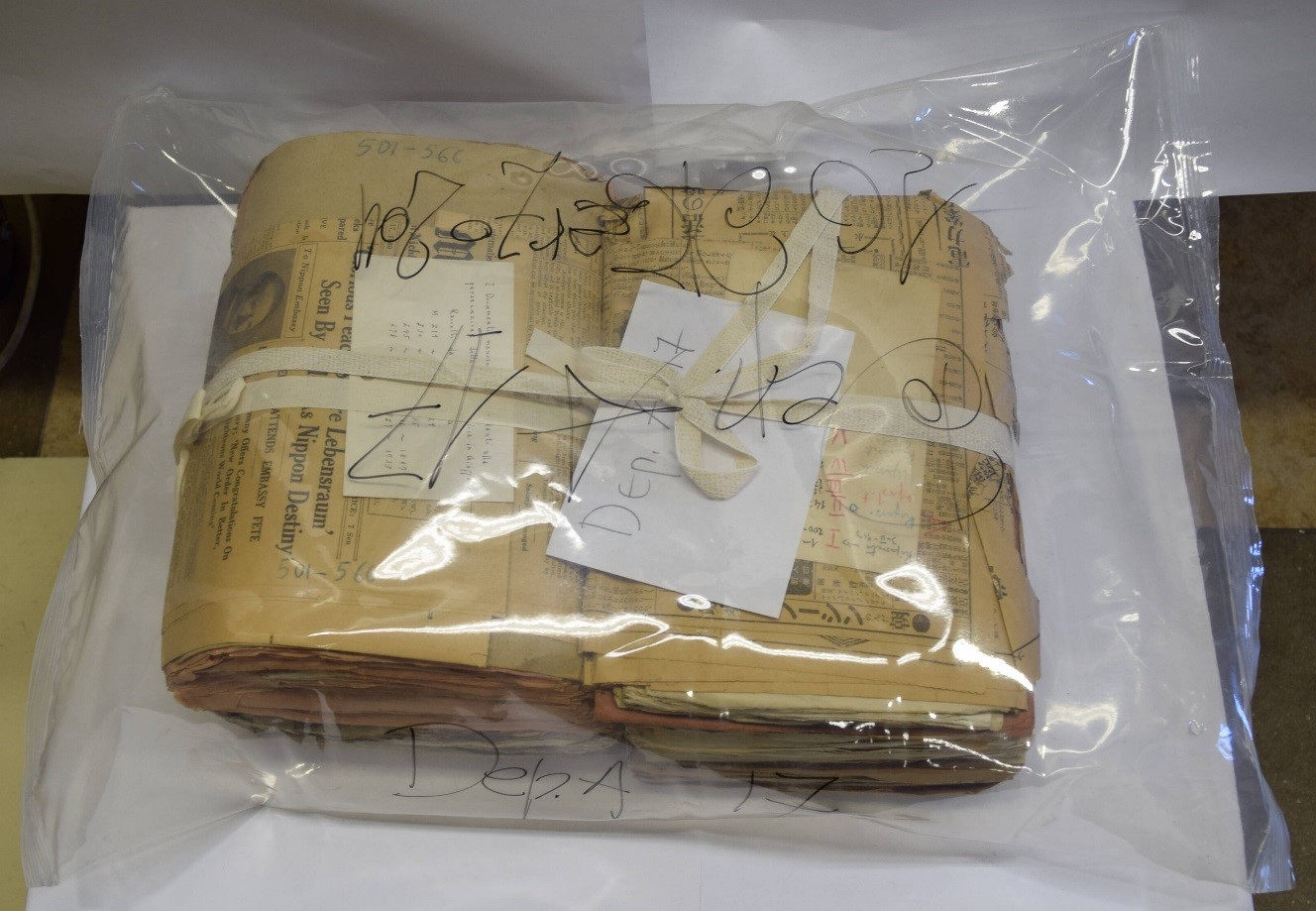- Reference Code
maregaA17
- Title
Fonds Marega File A17
- Date Range
- 1697–1940
- Primary Date Range
- 1697, 1834–1847
- Date Range Notes
- 1697 (Genroku 10), 1834(Tenpō 5) –1847(Kōka 4)
- Description Level
File
- Quantity
- 280 records (22 jō 状, [includes 3 moto tatechō 元竪帳, 3 ori 折, 2 with harigami 貼紙], 151 tatechō [26 with harigami], 4 tsuzuri 綴, 5 newspapers, 10 envelopes, 69 hōshi 包紙, 6 atsugami 厚紙, 1 card, 12 strips of paper)
- Notes on Physical State
- A17 is comprised of three groups of documents that were placed together in a preservation bag. In the survey numbers were assigned to each of these groups. A17.1 is a sizeable group of documents that were wrapped in an English language newspaper (approx. 30 cm x 22 cm) and tied together with cotton tape. There was one handwritten card (approx. 7 cm x 13 cm) attached. There was thick paper (atsugami) under and inside the newspaper, apparently for preservation purposes. Almost all of the documents were placed between pink thin sheets of paper. A17.2 is comprised of tatechō that were wrapped in thick paper and Japanese newspaper. A17.3 is comprised of many thin tatechō and jō that were wrapped in thick paper and Japanese newspaper, on top of which was a card. With almost all documents were envelopes containing memos, apparently written by Marega himself, as well as thin pieces of paper. The above gives one the impression that overall A17 was a set of documents on which much categorization / organization work had been carried out.
- Provenance / Creation
- Father Mario Marega. The komonjo 古文書 (archival documents) are originally from the Usuki Domain's Office of Religious Affairs (shūmonkata 宗門方).
- Biographical History
- Same as fonds.
- Place Name
- Usuki City and Ōita City, Ōita Prefecture; Himon’ya, Meguro City, Tōkyō-to
- Positions, etc
- Salesians of Don Bosco missionary
- Archival History
- Donated to the Vatican by Mario Marega in 1953.
- Acquisition Source
- Same as fonds.
- Scope and Content
Comprised of Marega-related materials and Usuki Domain Office of Religious Affairs documents collected by Marega. The Marega-related documents were packed in newspapers: A17.1 in an English language newspaper (The Osaka Mainichi) dated November 17th 1940, A17.2 in a Hōshū shimbun 豊州新聞 dated November 13th 1940, and A17.3 in a November 13th 1940 and February 3rd 1938 Ōita shimbun 大分新聞. Marega may have subscribed to these newspapers. Also, we can see that he had an opportunity to pack historical materials on day(s) shortly after November 17th 1940. While very limited in number, the packing materials used to categorize the historical materials include envelopes and a flier for a talk (“Kojiki and the Bible”) that share with us both those with whom Marega kept in touch and his research activities. On the attached card someone, probably not Marega, wrote “Don Marega.” There is room to investigate who categorized / organized these materials and when they did so.
The documents from the Usuki Domain Office of Religious Affairs are shūmon oaratame ni tsuki maitsuki shiage gonin gumi okakimono 宗門御改ニ付毎月仕上五人組御書物 (five household unit documents submitted monthly for religious inquisition) from Tenpō 5 (1834) and Bunsei 13 (1830) to Kōka 4 (1847), as well as seishideiri no oboe 生死出入之覚 (notifications regarding birth, death, and moving). The latter include notifications that are stand-alone jō as well as well as ones that are bound to the former tatechō. It appears that these documents were submitted by village officials to the Usuki Domain's Office of Religious Affairs. A17.2 contains Kanai ninzū no oboe家内人数之覚 (notifications about retainer numbers) from Genroku 10 (1697). There are jō and ones grouped together to an extent as a tatechō. It appears that they were submitted by warrior units (kumi 組), guardians (shihai 支配; warrior unit representatives and their subordinates), and family heads (kachō 家長; domain retainers). The majority of A17.3 is comprised of shūmon oaratame ni tsuki mai tsuki shiageokakimono 宗門御改ニ付毎月仕上御書物 (documents submitted monthly regarding religious inquisitions) from the Kansei (front page only), Bunsei, Tenpō, and Kōka years (approximately from the latter half of the eighteenth century to the first half of the nineteenth century). Like A17.1, the seishideiri no oboe stand alone or are brought together as tatechō. Additionally, there are two booklets regarding Christian fumie inquisition organized by family entitled kirishitan shūmon fumie oaratame ni tsuki kanai chō 切支丹宗門踏絵御改ニ付家内帳 from Tenpō 15 (1844). At the beginning of each are so-called “Southern Barbarian oaths” (nanban seishi 南蛮誓詞) attesting to Christian and Japanese gods that one is not Christian. These were employed in the period soon after Christianity was banned and their use here is rather interesting.
Some documents include numbers assigned by Marega for organizational purposes (Marega numbers). In A17.1 there are documents M501 to 566 (1), in A17.2 documents M567 to 631 (2), and in A17.3 documents M248 to 266 (3) as well as M348 to 384 (some missing) (4). Excluding (3), these Marega numbers are also listed on the A10.1.1 card. On this card is also written the numbers 305–321, 386–392, and 427–500. 305 to 321 are in A5, and 427–500 in A10. We also find nōmin to heishi no dōtai chōsa 農民と兵士の動態調査 (farmer and soldier movement surveys) as well as kozutsumi bangō 2 ban 小包番号2番 (package no. 2) written on the card. It therefore appears that while when the card was made parts of A5, A10, A17, etc., were included in the same package, these were then separated out during preservation / management work.
From the above-described scope and content of these documents, we can tell that Marega and the Vatican Library had different approaches to the categorization and organization methods for these documents. We should pay attention to who categorized and organized these documents, when they did so, as well as their approach to doing so.
- Languages Used
- Japanese, Italian, English (newspaper)
- Date Description Written
- 2018/11/18
- Reference Images

